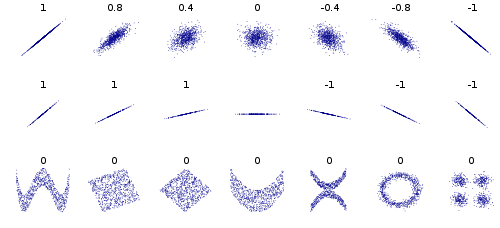Quantifying statistical dependence¶
As we saw earlier, two random variables may be uncorrelated (the covariance of two random variables may be zero), but that does not imply the two variables are independent. This figure from the wikipedia article on Correlation and Dependence is a good illustration. The bottom row shows examples of two variables that are uncorrelated, but not statistically independent (eg. we can’t factorize the joint \(p(X,Y)\) as \(p(X)p(Y)\)).
So how can we quantify if and two what degree two variables are statistically dependent?
Mutual Information¶
The Mutual information is of two random variables is a measure of the mutual dependence between the two variables. It quantifies the “amount of information” obtained about one random variable through observing the other random variable. The concept of mutual information is intimately linked to that of entropy of a random variable, a fundamental notion in information theory that quantifies the expected “amount of information” held in a random variable.1
Important
The mutual information \(I(X;Y)=0\) if and only if \(X \indep Y\).
The mutual information of two jointly discrete random variables \(X\) and \(Y\) is calculated as a double sum
where \({\displaystyle p_{(X,Y)}}\) is the joint probability mass function of \(X\) and \(Y\) and \(p_{X}\) and \(p_Y\) are the marginal probability mass functions.\(X\) and \(Y\) respectively.
In the case of jointly continuous random variables, the double sum is replaced by a double integral
where \({\displaystyle p_{(X,Y)}}\) is now the joint probability density function and \(p_{X}\) and \(p_Y\) are the marginal probability density functions.
If the log base 2 is used, the units of mutual information are bits.
An equivalent formulation is
where \(D_{{{\mathrm {KL}}}}\) is the Kullback–Leibler divergence, which we will return to later in the course. Here we see that it is the KL distance between the joint and the product of the two marginals, and so it is only zero if the those are identical, which is equivalent to saying \(p(X,Y)= p(X)p(Y)\), which is the definition of independence.
Another useful identity is:
where \({\displaystyle \mathrm {H} (X)}\) and \({\displaystyle \mathrm {H} (Y)}\) are the marginal entropies, \({\displaystyle \mathrm {H} (X|Y)}\) and \({\displaystyle \mathrm {H} (Y|X)}\) are the conditional entropies, and \({\displaystyle \mathrm {H} (X,Y)}\) is the joint entropy of \(X\) and \(Y\).
Note
The mutual information is symmetric \(I(X;Y)=I(Y;X)\) and non-negative \(I(X;Y)\ge 0\).
Distance Correlation¶
Distance Correlation is a measure of dependence between two paired random vectors of arbitrary, not necessarily equal, dimension. Thus, distance correlation measures both linear and nonlinear association between two random variables or random vectors. This is in contrast to Pearson’s correlation, which can only detect linear association between two random variables 2.
Important
The distance correlation is zero if and only if \(X \indep Y\).
- 1
Adapted from https://en.wikipedia.org/wiki/Mutual_information
- 2
Adapted from https://en.wikipedia.org/wiki/Distance_correlation

